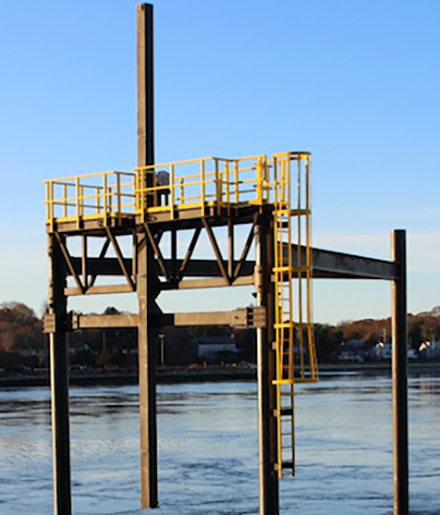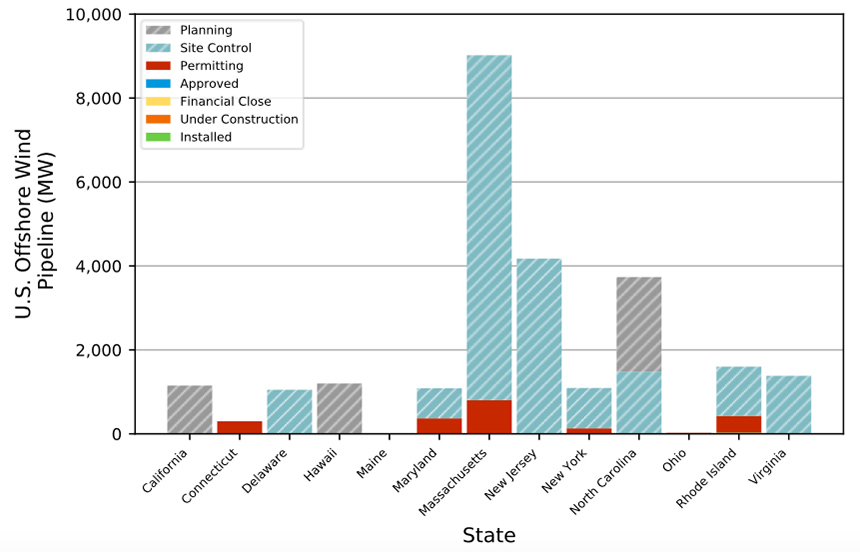By TIM FAULKNER/ecoRI News staff
 |
| A tidal current platform in the Cape Cod Canal will soon test its first underwater turbine. (Marine Renewable Energy Collaborative) |
Efforts to generate electricity from
waves and tidal currents have slowed in southern New England, as offshore wind
power takes a commanding lead in the renewable-energy portion of the so-called
“blue economy.”
In recent years, tidal- and
wave-energy programs at Brown University, University of Massachusetts
Dartmouth, and the University of Rhode Island have curtailed their research and
commercial collaborations.
At Brown, the Leading Edge project has shifted from an
academic and commercial venture to a school-based laboratory-research project.
Engineering students designed oscillating hydrofoils that generate electricity from rectangular blades that lift and rotate in strong currents.
Faculty leaders, however, have gone to other schools or are on sabbatical, thereby halting commercial partnerships.
Engineering students designed oscillating hydrofoils that generate electricity from rectangular blades that lift and rotate in strong currents.
Faculty leaders, however, have gone to other schools or are on sabbatical, thereby halting commercial partnerships.
The program was funded by the
federal Advanced Research Projects Agency–Energy
(APRA-E) program, which supports energy initiatives that private investors
consider too risky.
Leading Edge partnered with
Portsmouth, R.I.-based BluSource Energy Inc. to build and test
underwater turbines in the Taunton River and at the Massachusetts Maritime
Academy at the entrance of the Cape Cod Canal.
Tom Derecktor, CEO of BluSource, said the turbine succeeded in producing uninterrupted electricity, something wind and solar can’t promise. But he noted the challenges of scaling hydrokinetic power for commercial production.
Large energy systems require open water or a river with a strong current, free from ship traffic and debris, conditions hard to find in the Northeast. Most currents with the desired speed of 4 knots or more are too far from population centers to host a permanent power system.
Still, Derekotor believes that tidal
energy can achieve scale in other parts of the country.
“There’s a lot of potential there,
but it requires a lot funding to take it to the next level,” he said.
Congress may help by increasing
funding for the APRA-E program, but Trump opposes the program and has
tried, unsuccessfully, to eliminate its funding.

Offshore wind-energy development by
state. (Department of Energy)
Meanwhile, offshore wind power is
taking off, with some 25 gigawatts of projects proposed across the country,
much of it in the Northeast, according to the Department of
Energy.
More then 10 gigawatts is planned for Massachusetts and Rhode Island waters, thanks to southern New England's large, windy, and relatively shallow offshore regions — all within range of millions of energy customers.
More then 10 gigawatts is planned for Massachusetts and Rhode Island waters, thanks to southern New England's large, windy, and relatively shallow offshore regions — all within range of millions of energy customers.
There is still hope for harnessing
energy from currents and waves. In 2014, UMass-Dartmouth closed its Marine
Renewable Energy Center, prompting the energy program to reorganize as the Marine Renewable Energy Collaborative (MRECo). The
nonprofit switched from its academic initiative to focus on public outreach,
promotion, and equipment testing.
MRECo’s executive director, John
Miller, said there isn’t adequate financial support to make tidal and wave
projects financially viable, especially as federal dollars have shifted to wave-energy
testing on the West Coast, such as the PacWave project off
the coast of Oregon.
“It’s a tough business,” Miller
said. “The whole business is 10 to 15 years behind where offshore wind is.”
Nevertheless, MRECo is testing a
range of marine-industry products. The organization recently concluded a study
that determined that current for the proposed Muskeget Channel tidal
installation between Nantucket and Martha’s Vineyard lacks the velocity to support
the latest tidal-energy systems.
In 2017, MRECo installed the Bourne
Tidal Test Site (BTTS) in the Cape Cod Canal. Miller noted that the $300,000
steel platform was a bargain to build compared to more elaborate facilities off
the coast of Scotland and in the Bay of Fundy in Canada that cost $30 million
apiece.
Within a year, BTTS expects to test
its first underwater turbine, a device for the start-up company Littoral
Power Systems of Fall River, Mass. BTTS has hosted other marine
equipment, including commercial fishing nets and soon will gather data for
aquatic sensors that monitor microplastics and algae linked to toxic blooms.
MRECo is seeking $200,000 to upgrade
the power and internet capability of BTTS to accommodate testing of additional
marine sensors and instruments.
At URI, the ocean-energy research
labs and indoor wave tank have broadened their study areas to include the
offshore wind industry.
Professor M. Reza Hashemi said wave
and tidal power are some of the oldest forms of energy but have yet to be
proven commercially viable in New England, primarily because water currents
aren’t strong enough.
“There is hope, but it needs a lot
help,” Hashemi said.
Wave and tidal energy are more promising
on the West Coast and in the United Kingdom, where the currents are much
stronger, he said.
But local tidal- and wave-energy
efforts haven’t stopped. The massive tides in the Gulf of Maine and North
Atlantic are drawing demonstration projects supported by research from URI and
the University of New Hampshire, among others.
Hashemi also co-authored a textbook about wind,
tidal, and wave energy. For now, he is conducting research on the impacts of
hurricanes on wind turbines.
But Hashemi and URI remain dedicated to hydrokinetic energy. The university recently received $148,000 from The Champlin Foundation for a new ocean-energy flume, a type of indoor wave tank designed for testing small-scale wave- and tidal-energy devices.
But Hashemi and URI remain dedicated to hydrokinetic energy. The university recently received $148,000 from The Champlin Foundation for a new ocean-energy flume, a type of indoor wave tank designed for testing small-scale wave- and tidal-energy devices.
“Wave and tidal energy are still at
the early stages of development,” Hashemi said. “They are not yet at the
commercial stage.”